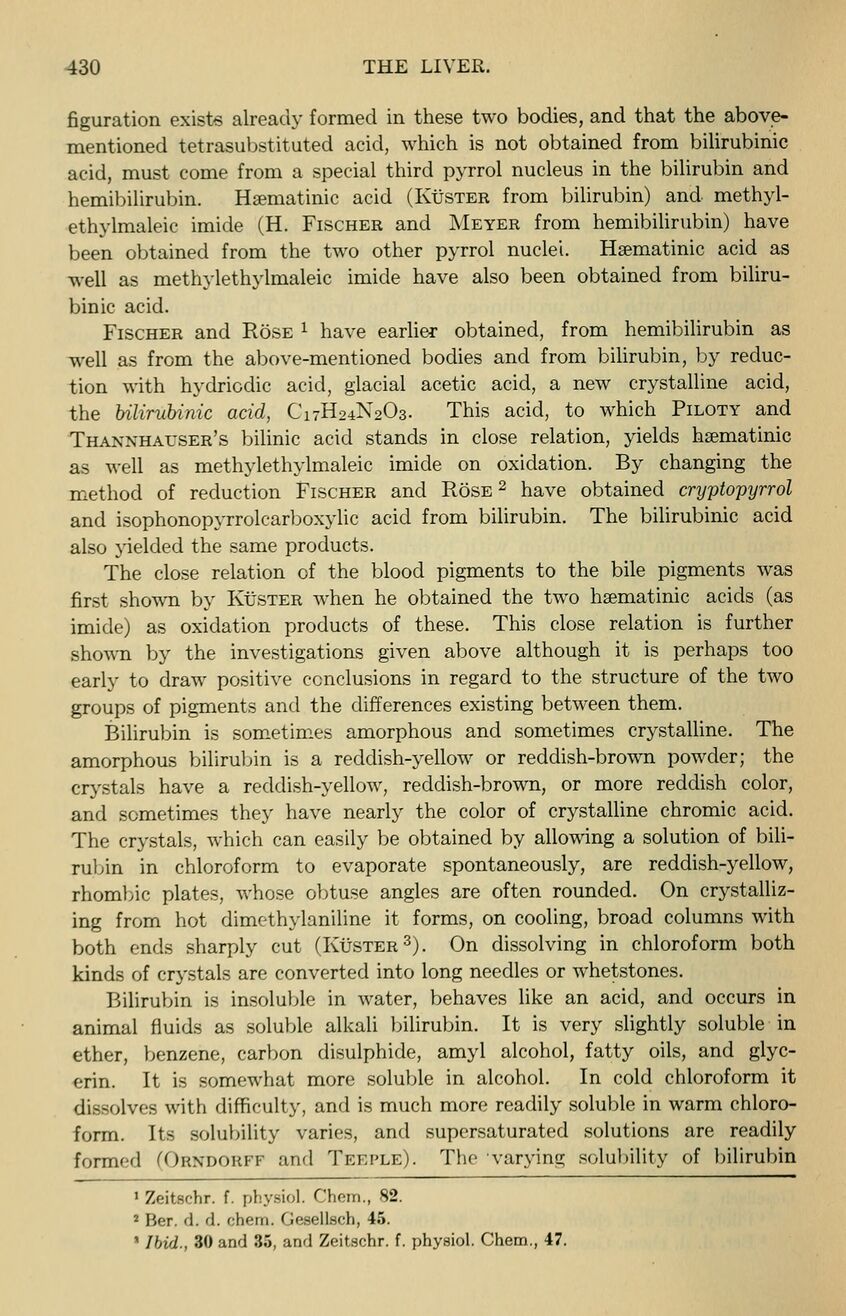
Full resolution (JPEG) - On this page / på denna sida - VII. The Liver - The Bile and its Formation

<< prev. page << föreg. sida << >> nästa sida >> next page >>
Below is the raw OCR text
from the above scanned image.
Do you see an error? Proofread the page now!
Här nedan syns maskintolkade texten från faksimilbilden ovan.
Ser du något fel? Korrekturläs sidan nu!
This page has never been proofread. / Denna sida har aldrig korrekturlästs.
430 THE LIVER.
figuration exists already formed in these two bodies, and that the above-
mentioned tetrasubstituted acid, which is not obtained from bilirubinic
acid, must come from a special third pyrrol nucleus in the bilirubin and
hemibilirubin. Hsematinic acid (Kuster from bilirubin) and methyl-
ethylmaleic imide (H. Fischer and Meyer from hemibilirubin) have
been obtained from the two other pyrrol nuclei. Hsematinic acid as
well as methylethylmaleic imide have also been obtained from biliru-
binic acid.
Fischer and Rose * have earlier obtained, from hemibilirubin as
well as from the above-mentioned bodies and from bilirubin, by reduc-
tion with hydricdic acid, glacial acetic acid, a new crystalline acid,
the bilirubinic acid, C1-H24N2O3. This acid, to which Piloty and
Thannhauser’s bilinic acid stands in close relation, yields hsematinic
as well as methylethylmaleic imide on oxidation. By changing the
method of reduction Fischer and Rose 2
have obtained cryptopyrrol
and isophonopyrrolcarboxylic acid from bilirubin. The bilirubinic acid
also yielded the same products.
The close relation of the blood pigments to the bile pigments was
first shown by Kuster when he obtained the two hsematinic acids (as
imide) as oxidation products of these. This close relation is further
shown by the investigations given above although it is perhaps too
early to draw positive conclusions in regard to the structure of the two
groups of pigments and the differences existing between them.
Bilirubin is sometimes amorphous and sometimes crystalline. The
amorphous bilirubin is a reddish-yellow or reddish-brown powder; the
crystals have a reddish-yellow, reddish-brown, or more reddish color,
and sometimes they have nearly the color of crystalline chromic acid.
The crystals, which can easily be obtained by allowing a solution of bili-
rubin in chloroform to evaporate spontaneously, are reddish-yellow,
rhombic plates, whose obtuse angles are often rounded. On crystalliz-
ing from hot dimethylaniline it forms, on cooling, broad columns with
both ends sharply cut (Kuster 3
). On dissolving in chloroform both
kinds of crystals are converted into long needles or whetstones.
Bilirubin is insoluble in water, behaves like an acid, and occurs in
animal fluids as soluble alkali bilirubin. It is very slightly soluble in
ether, benzene, carbon disulphide, amyl alcohol, fatty oils, and glyc-
erin. It is somewhat more soluble in alcohol. In cold chloroform it
dissolves with difficulty, and is much more readily soluble in warm chloro-
form. Its solubility varies, and supersaturated solutions are readily
formed (Orndorpf and Teeple). The varying solubility of bilirubin
1
Zeitschr. f. physio]. Choin., 82.
2
Ber. d. d. chem. Gesellsch, 45.
’ Ibid., 30 and 35, and Zeitschr. f. physiol. Chem., 47.
<< prev. page << föreg. sida << >> nästa sida >> next page >>